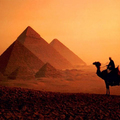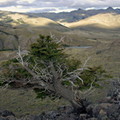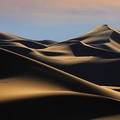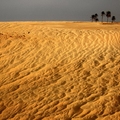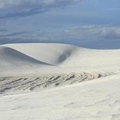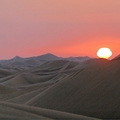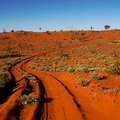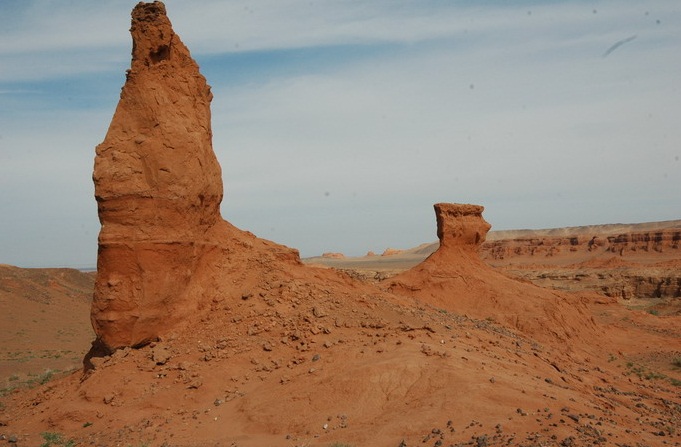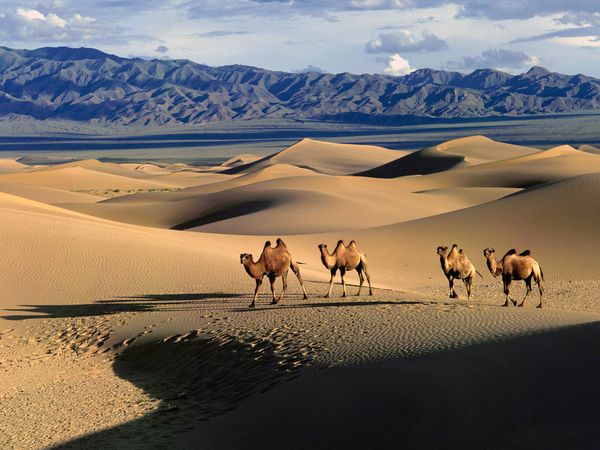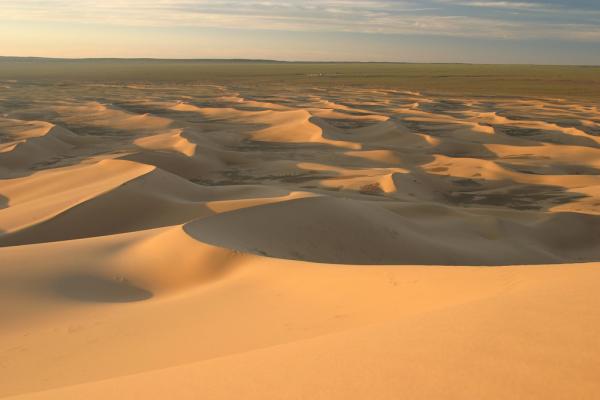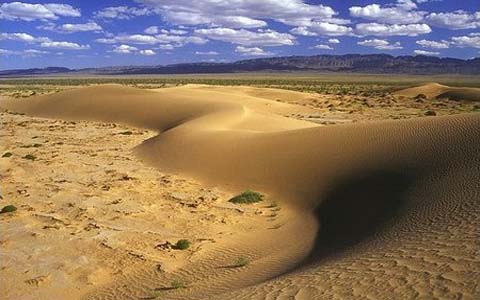Eco-friendly locations / The Largest Deserts in the World / The Gobi Desert
The Gobi Desert
The Gobi desert occupies the entire southern part of Mongolia (about one-third of the country). The name itself is translated from the Mongolian language meaning barren terrain. Since ancient times this area was known as the Shamo desert. The territory of the Gobi desert occupies the entire southern half of Mongolia and the northern provinces of China. This covered stones plain was called by a Chinese the endless sea. This plain is the largest desert of Asia, the fifth largest in the world. It covers the north part of China and the south of Mongolia.
Description
The Gobi is one of the most notable desert in the history of the deserts. Its territory was part of the great empires where the Silk Road lays. The Gobi desert, raised above the sea level to an altitude of about 200-1000 meters is the most extreme continental destination on the planet. The air temperature in summer rises to 40 here, and in winter it drops to 40. The concept of the Gobi includes, as the Mongols say, thirty-three different climates and appearances. The Zaaltayskoy, the Junggar, the East Mongolian Gobi landscapes are diverse. There are not only waterless and barren terrains with sandy plains and undulating high dunes. Most of it is occupied with vast prairie plains with springs, picturesque rocky mountains, rocky clays, large basins with a few oases, hills, marshes, dry gravels and extensive green groves. Golden sands occupy only 3% of its territory, but the clayey and stony deserts occupy a huge area. Despite the arid climate the desert meets the crystal clear water springs and abundant wildlife. The desert is home to rare mountain sheep in the world, argali, Asiatic wild ass, saiga antelopes, gazelles and dzeren. The natural reserve islands of salvation in the heart of the Gobi remained rare endemics: the world's only natural population of wild camel, Gobi bear Mazal. For about 40 million years, the Gobi remained a dry land, not covered by sea water. Large inland waters with deep waters in the south of Mongolia were associated with reservoirs in northern China and cover a vast area in the center of Asia. Their disappearance is associated with a gradual uplifting throughout, which led to the emergence of later Gobi Desert.
Interesting facts
In the desert region of Central Asia, in the foothills of the Kunlun Mountains, until recently, most of the remains of the oldest person on the Earth were found. This was the birth of a hypothesis about the alleged birthplace of the human race. For this Occult Central Asia is a region where there were spiritual centers of all races. Anhydrous and unfit for human habitation today the central Gobi region is mentioned in ancient myths as a place where our civilization began. The location of the mythical White Island, a mysterious underground country Agartha, Shambhala the sacred borders of the Gobi are also localized here. A summer in the desert is a deadly fever, and also up to forty degrees. Giant fluctuations in temperature can be observed not only in a year, but even within a day. The temperature in the Gobi Desert makes a daily jumping as much as 32 degrees! The Gobi desert is a strange place. On the one hand, it is home to animals such as black-tailed gazelle or two-humped camel - nothing special, right? - But on the other hand , there are predators like to go and see, for example, the snow leopard and the brown bear. And even the dinosaurs in the Gobi ... were, once upon a time, a long time ago. By the way, the Gobi is famous for the fact that the first dinosaur eggs were found in the desert. There were found, and other treasures , such as the remains of prehistoric mammals, as well as prehistoric implements, whose age are estimated at about 100 thousand years.
Others The Largest Deserts in the World .
Maps of The Gobi Desert
mapOthers from The Largest Deserts in the World
Under such dry conditions it is hard for the plants to live and the soils to form.
There is anything that protects the earth from overheating in these areas.
The hottest place on the Earth is the tropical desert, but there are coldest , even icy deserts, for instance, Antarctica.
Deserts cover approximately 20% of the Earth's land surface and 80% in Australia , therefore, a fifth of the Earth's land area belongs to the deserts.
Many of the major deserts are located near the tropics, such as the Sahara desert which is the largest desert in the world, as well as the Kalahari, the Namib Desert and the Grand Victoria in Australia.
Droughts During the grazing of cattle during droughts disorders of vegetation occur.
They are so significant that are likely unrecovered.
The sun's rays quickly dry the soil and turn to dust, which happens to desertification, a continuous transformation of the land in the desert.
A desert with a change in climatic conditions can always shrink and expand.
The long-term global climate change or contraction of the continents can garden the desert or turn it into a magnificent forest.
Short-lived changes in weather conditions influence the expansion of its borders, turning occasionally green areas in arid deserts.
The hottest places on the Earth are the tropical desert, where the daytime temperatures often reach +50 ° C.
This heat can destroy the stones and give the landscape an unusual character.
The underground water evaporates so quickly that minerals are dissolved from the crust.
Deserts are constantly dry, but in other natural areas prolonged dry periods can occur - the droughts.
Their presence in any place depends on what kind of rainfall is there.
There was a drought in Sahel, Africa, that lasted many months without rain.
However, droughts are regular and in some places they are with a typical moisture content, such as the North American grasslands which dry up every 22 years.
Water plays a significant role in shaping the dry landscape, despite of its low quantity in the desert .
Water alters the chemical composition of rocks, now and then it is dumped in the desert from the sky, at times becoming the cause of short, but strong flash floods, which are harmful to the soil.
Do all the deserts have very high temperatures and a lot of sand? We call a desert an area where not more than 25 inches of rain falls per year.
As a rule, deserts are formed in the hot desert climates, but there are exceptions.
Most deserts have a lot of rocks and stones and sand.
What is the biggest desert? The most extensive deserts are located in areas of high atmospheric pressures.
All the winds blow in areas of their inner regions, but the moist winds from the sea reach them very rarely.
There are those deserts, which are near the sea, and yet the sea winds will reach them, they lose most of moisture on the way.
Certain deserts are formed on the internal continental slopes of mountain ranges, well sheltered from the sea winds.
Almost all of Antarctica is a huge frozen desert, which is located in an area of high pressure, so that its interior is extremely small drops of fresh snow.
The driest desert in the world.
In many deserts there is no rain for several years in a row, then a short downpour happens and everything starts all over again.
The most arid desert is the Atacama Desert in South America .
Until 1971, there were 400 years without spilling a drop.
It is known that in several places in the desert, there are artesian waters, but the high boron content makes them unsuitable for irrigation.
What is an oasis? An oasis is a plot of land in the desert, which is covered with vegetation.
It feeds from underground springs or natural wells.
The largest desert in the world The largest desert in the world is the Sahara Desert in North Africa.
Its area is of approximately 8400 sq.
km.
However, only ten percent of its territory is covered with sand, and everything else is taken by bare rocks and stones.
After Sahara, we have the Arabian desert, the Gobi, the Patagonian,the Rub’ al Khali, the Great Victoria, the Kalahari, the Great Basin, the Chihuahuan and the Thar.

